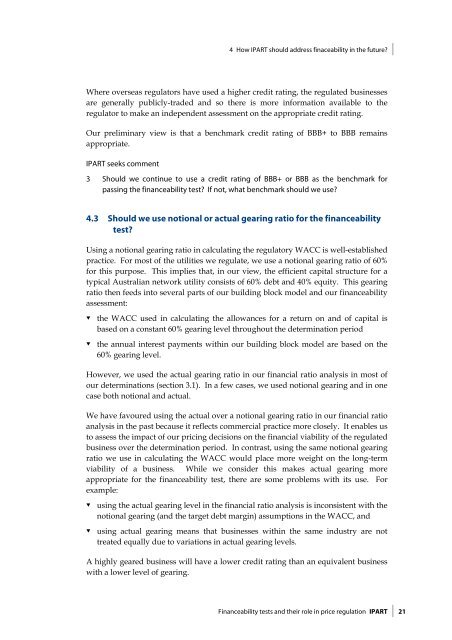Financeability tests and their role in price regulation - IPART - NSW ...
Financeability tests and their role in price regulation - IPART - NSW ...
Financeability tests and their role in price regulation - IPART - NSW ...
Create successful ePaper yourself
Turn your PDF publications into a flip-book with our unique Google optimized e-Paper software.
4 How <strong>IPART</strong> should address f<strong>in</strong>aceability <strong>in</strong> the future?<br />
Where overseas regulators have used a higher credit rat<strong>in</strong>g, the regulated bus<strong>in</strong>esses<br />
are generally publicly-traded <strong>and</strong> so there is more <strong>in</strong>formation available to the<br />
regulator to make an <strong>in</strong>dependent assessment on the appropriate credit rat<strong>in</strong>g.<br />
Our prelim<strong>in</strong>ary view is that a benchmark credit rat<strong>in</strong>g of BBB+ to BBB rema<strong>in</strong>s<br />
appropriate.<br />
<strong>IPART</strong> seeks comment<br />
3 Should we cont<strong>in</strong>ue to use a credit rat<strong>in</strong>g of BBB+ or BBB as the benchmark for<br />
pass<strong>in</strong>g the f<strong>in</strong>anceability test? If not, what benchmark should we use?<br />
4.3 Should we use notional or actual gear<strong>in</strong>g ratio for the f<strong>in</strong>anceability<br />
test?<br />
Us<strong>in</strong>g a notional gear<strong>in</strong>g ratio <strong>in</strong> calculat<strong>in</strong>g the regulatory WACC is well-established<br />
practice. For most of the utilities we regulate, we use a notional gear<strong>in</strong>g ratio of 60%<br />
for this purpose. This implies that, <strong>in</strong> our view, the efficient capital structure for a<br />
typical Australian network utility consists of 60% debt <strong>and</strong> 40% equity. This gear<strong>in</strong>g<br />
ratio then feeds <strong>in</strong>to several parts of our build<strong>in</strong>g block model <strong>and</strong> our f<strong>in</strong>anceability<br />
assessment:<br />
� the WACC used <strong>in</strong> calculat<strong>in</strong>g the allowances for a return on <strong>and</strong> of capital is<br />
based on a constant 60% gear<strong>in</strong>g level throughout the determ<strong>in</strong>ation period<br />
� the annual <strong>in</strong>terest payments with<strong>in</strong> our build<strong>in</strong>g block model are based on the<br />
60% gear<strong>in</strong>g level.<br />
However, we used the actual gear<strong>in</strong>g ratio <strong>in</strong> our f<strong>in</strong>ancial ratio analysis <strong>in</strong> most of<br />
our determ<strong>in</strong>ations (section 3.1). In a few cases, we used notional gear<strong>in</strong>g <strong>and</strong> <strong>in</strong> one<br />
case both notional <strong>and</strong> actual.<br />
We have favoured us<strong>in</strong>g the actual over a notional gear<strong>in</strong>g ratio <strong>in</strong> our f<strong>in</strong>ancial ratio<br />
analysis <strong>in</strong> the past because it reflects commercial practice more closely. It enables us<br />
to assess the impact of our pric<strong>in</strong>g decisions on the f<strong>in</strong>ancial viability of the regulated<br />
bus<strong>in</strong>ess over the determ<strong>in</strong>ation period. In contrast, us<strong>in</strong>g the same notional gear<strong>in</strong>g<br />
ratio we use <strong>in</strong> calculat<strong>in</strong>g the WACC would place more weight on the long-term<br />
viability of a bus<strong>in</strong>ess. While we consider this makes actual gear<strong>in</strong>g more<br />
appropriate for the f<strong>in</strong>anceability test, there are some problems with its use. For<br />
example:<br />
� us<strong>in</strong>g the actual gear<strong>in</strong>g level <strong>in</strong> the f<strong>in</strong>ancial ratio analysis is <strong>in</strong>consistent with the<br />
notional gear<strong>in</strong>g (<strong>and</strong> the target debt marg<strong>in</strong>) assumptions <strong>in</strong> the WACC, <strong>and</strong><br />
� us<strong>in</strong>g actual gear<strong>in</strong>g means that bus<strong>in</strong>esses with<strong>in</strong> the same <strong>in</strong>dustry are not<br />
treated equally due to variations <strong>in</strong> actual gear<strong>in</strong>g levels.<br />
A highly geared bus<strong>in</strong>ess will have a lower credit rat<strong>in</strong>g than an equivalent bus<strong>in</strong>ess<br />
with a lower level of gear<strong>in</strong>g.<br />
<strong>F<strong>in</strong>anceability</strong> <strong>tests</strong> <strong>and</strong> <strong>their</strong> <strong>role</strong> <strong>in</strong> <strong>price</strong> <strong>regulation</strong> <strong>IPART</strong> 21

















